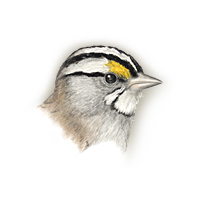|
Field
Guide IDs: BREEDING:
Conif and mixed
conif-decid forest, edge and clearings, thickets,
open woodland. 1, occ 2 broods. DISPLAYS:
Courtship: female
flutters wings and trills. NEST:
Usu at edge of
clearing, well concealed; of coarse grass, wood
chips, twigs, pine needles, rootlets, lined with
fine materials. Female probably selects
site. EGGS:
Greenish-, bluish-,
or creamy-white, marked with reddish-browns. 0.8"
(21 mm). DIET:
Includes few
spiders, millipedes, snails; forb, grass and tree
seeds. CONSERVATION:
Winters s to n e
Mexico. Uncommon cowbird host. NOTES:
White-striped (WS)
and tan-striped (TS) adults tend to mate with
opposite-colored morphs; experiments show that male
WS are more aggressive than male TS toward singing
birds and that female WS sing, thus WS males likely
drive off WS females and mate with TS females,
which do not sing. Males tend to return to same
breeding territory each year. Often sing at night.
Foraging behavior largely determined by proximity
to cover. Immature and first-year females tend to
winter farther s than adults; adult males tend to
winter in n. Often associate with other sparrows in
winter. Birds in winter flocks form stable
dominance hierarchies. ESSAYS: Vocal
Functions;
Dominance
Hierarchies;
Migration;
Site
Tenacity REFERENCES:
Atkinson and Ralph,
1980; Knapton et al., 1984; Schneider,
1984. |
